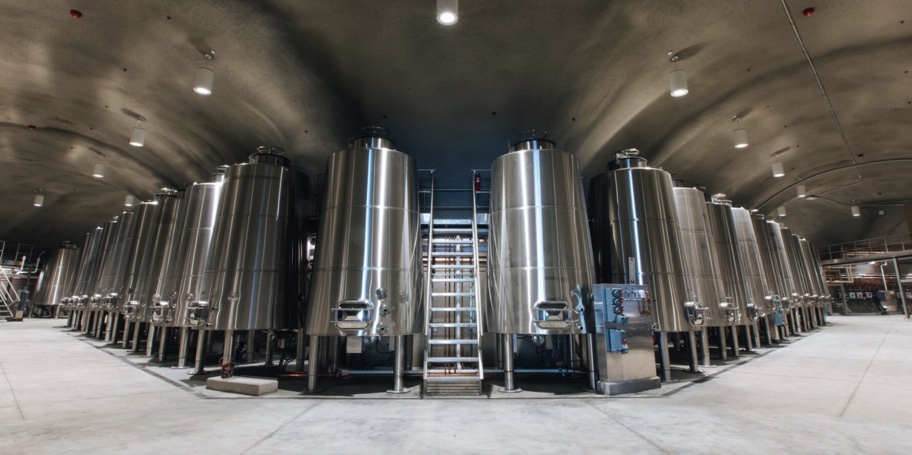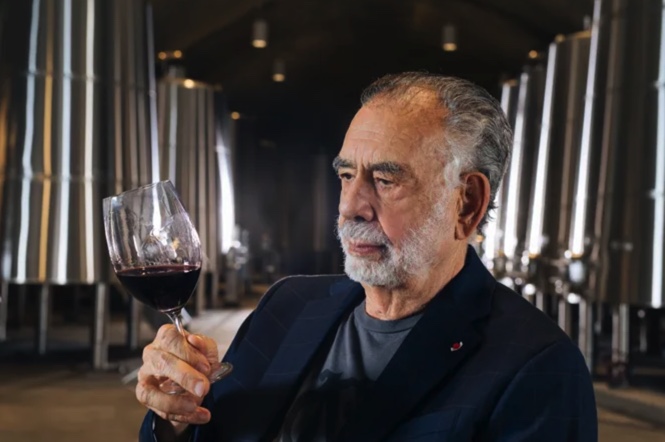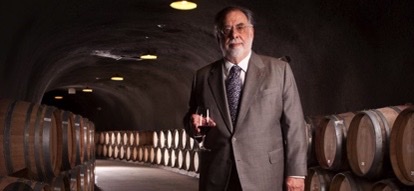Inglenook Unveils Spectacular 22,000 Square-Foot Winery Cave,
Featuring 120 Remotely Controlled Fermentation Tanks
That are Aligned with each Organically Farmed Vineyard Block
Complex design includes 30 miles of wire, 6 miles of conduit,
1,000 cubic yards of low CO2 concrete,
and a separate room for white wine fermentation

RUTHERFORD, California (August 25, 2022) – Francis Ford Coppola, the proprietor ofInglenook, is pleased to announce the estate’s new winery cave, distinctive for its complex engineering, size, function and dedication to specificity and customization, has been completed. The new winery will be used for the first time for this year’s harvest.
“Most wineries design caves for barrel aging and storage, but we are proud that ours stands out as a 22,000 square-foot production cave where our winemaking team can craft Inglenook’s world-renowned, elegant wines. Our new winery cave is so astounding, extensive and spectacular in its visuals, dimensions, and sheer audacity,” said Coppola. “Together with my family, I am just the third steward of this legendary estate. Since it was founded in Napa Valley in 1879, Inglenook has been recognized around the world for its innovation and industry leadership. This new production cave is another shining achievement in Inglenook’s illustrious 143-year history.”
The Details
Taking a cue from winemaking facilities from centuries ago, Inglenook’s new winery is eco-friendly and does not require heating and cooling, as caves naturally maintain cooler temperatures throughout the year. Novel in its approach and tucked beneath a knoll on the south side of the estate, the cave is also safe from the occasional threat of wildfire. No flammable elements were used, and the entire cave is protected by sprinklers.
Because winery caves are not usually equipped for production, adapting Inglenook’s new winemaking facility to a cave environment was an intricate engineering challenge that ultimately centralized winemaking operations to optimize production flow. One of the most notable features is the addition of 120 brand new insulated, remotely-controlled stainless steel fermentation tanks – each assigned to a different nuanced block in Inglenook’s 235-acre organically farmed vineyard. It’s remarkable for a winery that produces fewer than 30,000 cases of wine per year to have 120 dedicated tanks, and while perhaps more common in Bordeaux, this is an extraordinary feat in Napa Valley. Thirty miles of electrical and communications wiring run through six miles of conduit in the new cave, underneath more than 1,000 cubic yards of low CO2 concrete.

Each fermentation tank is equipped with a dedicated pump for pump-overs and thermal regulation hardware. Cutting-edge software allows the winemaking team to remotely monitor subtle fluctuations in fermentation dynamics as the grapes ferment in the tanks just after being harvested. For example, the winemaking team will be notified immediately if a fermentation stalls in the middle of the night, and they can remotely and instantly increase the temperature within the tank, ensuring the quality of the wine at a critical time in the winemaking process. The tanks range in size from one-half ton to 27 tons, and are proportionately tall and narrow in diameter. Inglenook’s Director of Winemaking, Philippe Bascaules, favors tanks for red wine fermentation that are somewhat taller and narrower in diameter, which results in a smaller extraction surface relative to the juice volume. This gives Phlippe and the winemaking team greater control over the extraction, ultimately leading to more elegant, nuanced wines. Raising the bar on quality winemaking even further, Inglenook has a separate temperature-controlled room devoted exclusively to the making of Inglenook’s white wines, which are fermented in barrels and stainless steel drums.
“To have each tank allocated to one specific vineyard block is extraordinary, and this level of customization in our winemaking is an important advantage that enhances our ability to make the world-renowned wines for which Inglenook is known. We now have infinite possibilities, which will lead to even more complex wines,” said Philippe Bascaules, Inglenook’s director of winemaking. “I am very proud of everything the Inglenook team and our partners have accomplished in designing this new winery cave.”
The Inglenook team broke ground on the new winery at the end of 2018. The cave was excavated under a hillside vineyard near the estate’s majestic chateau, which was built in 1887. For structural integrity, a diamond-shaped cave was excavated around a solid, central mass – making it similar to a baseball diamond. The “pitcher’s mound” is the solid central support, surrounded by a diamond-shaped tunnel that extends from “home plate” at the cave’s eastern entrance, north to “first base,” west to “second base,” south to “third base,” and back to home plate, the cave’s portal. The portal’s look was inspired by the design of the entrance to the caves at Château Lafite Rothschild. During harvest, Inglenook’s organically farmed fruit will be carefully sorted by hand in the portal and bottling will occur in that same area later in the year.
An elaborate panel that controls all of the electricity, utilities, Wi-Fi, and customized controls for each tank, extends along the wall near “first base,” in the northern corner of the diamond-shaped tunnel. This is also where Inglenook’s new cave connects with the winery’s pre-existing 16,000 square-foot cave, which was excavated in 2003 to house the wines as they age in barrel beneath the estate’s chateau. A gentle two-foot slope from the back of the winery to the front, plus trench drains throughout, ensure that run-off from the winery and its crush pad will not flow into the estate’s storm drains.
The project began with excavation of the cave by Nordby Wine Caves and work progressed with Nordby Construction Company as General Contractor for the project.

Innovation, Experimentation, and Conservation at Inglenook
Inglenook has a rich history of leadership in the wine industry. Many of founder Gustave Niebaum’s innovations at Inglenook in the 1800’s became industry standards: Inglenook instituted the first sterile bottling process in Napa; it was the first to separate field debris from grapes; Inglenook planted Napa’s first Merlot in 1882; and Inglenook built its iconic chateau – the first gravity-flow winery – in 1887. At the time, it was considered one of the greatest winery structures in the Western Hemisphere. More recently…
- Organically farmed since the 1970’s, Inglenook was one of the first estates in Napa Valley to be certified organic in 1994. Further supporting Inglenook’s commitment to conservation and environmental stewardship, Inglenook has earned a LandSmart® certification and has initiated Napa Green certification.
- Only organic products are used to control fungi and pests in the vineyard.
- The release of natural insect predators and the use of organic compost are both common practices at Inglenook to preserve the estate’s ecosystem.
- In 1995 – in conjunction with the Napa County Land Trust – Inglenook granted a conservation easement for 394 undeveloped acres for the preservation and protection of land in its natural condition.
- In 2011 Inglenook amassed a fleet of electric cars to transport employees and guests around the estate, and in 2012 added larger electric “people movers.” In 2018 electric vans were added to the collection. Inglenook employees are also encouraged to ride bicycles on the estate. Recently, Inglenook acquired several new Ford F-150® Lightning™ All-Electric trucks.
- The new winery cave uses 480-volt electricity instead of 240-volt electricity, which increases energy efficiency.
- High-temperature steam is used to sanitize barrels, saving a significant volume of water that would traditionally be used to clean each barrel, and winery wastewater is recycled for vineyard irrigation.
- The winemaking team at Inglenook experiments constantly with canopy management, barrel trials, and trellis designs to enhance the quality of Inglenook’s wines and refine management of the estate’s natural resources.
Francis Ford Coppola’s Important Role in Inglenook’s History
Inglenook’s founder, Gustave Niebaum, won accolades in Paris and Australia and swiftly garnered international acclaim for Inglenook’s wines in 1889, just ten years after he founded the celebrated Napa Valley estate. That success was continued by his nephew, John Daniel, Jr. Most notably, Daniel’s 1941 Cabernet Sauvignon is still widely regarded by wine critics as one of the best wines of the 20th century. Sadly, Daniel sold Inglenook to a corporation in 1964 and for 11 years the people running Inglenook dismantled the original estate and strayed from its previous leaders’ commitment to excellence.
In 1975, Francis Ford Coppola and his wife, Eleanor, were searching for a modest vacation cottage and instead ended up purchasing Gustave Niebaum’s home and a portion of the original Inglenook estate. The Coppolas soon discovered the inherent treasure in what they had acquired and vowed to reunite the vineyards of the original estate and restore Inglenook’s esteemed reputation. Over the next 47 years the Coppola family produced their first vintage of Rubicon, Inglenook’s premier wine (1978); purchased the estate’s iconic chateau (1995); reunited all of the contiguous vineyards of the original Inglenook estate (1995); and bought back Inglenook’s name and trademark (2011).

Inglenook is best-known globally for its critically acclaimed Rubicon, Cabernet Sauvignon, RC Syrah, Sauvignon Blanc, and a distinctive Marsanne-Roussanne-Viognier blend called Blancaneaux. Inglenook’s wines are crafted in limited quantities and available across the country and around the world in select shops and restaurants, and at auctions. Here’s a link to photos of Inglenook’s new winery cave.
About Inglenook
Founded in 1879 by Gustave Niebaum as Napa’s first estate winery, Inglenook boasts an illustrious heritage, a renowned legacy of innovation and an outstanding portfolio of award-winning wines that have defined and established Napa as a world-class wine region. From Gustave Niebaum to John Daniel, Jr. to Francis Ford Coppola, Inglenook’s three principal stewards have shared a strong sense of vision and an unwavering passion to create a wine estate that hearkens back to the European tradition, producing original, distinctly Napa wines that rival the best in Europe. It remains the largest contiguous estate on the famed Rutherford Bench, Napa Valley’s finest area for producing spectacular Cabernet Sauvignon. Inglenook was also among the first Napa Valley wineries to have its vineyards certified organic more than 25 years ago.
The iconic Inglenook chateau was first constructed in 1887, and faithfully restored in 1997. Befitting the grandeur of the Inglenook estate, the chateau welcomes guests for seated tastings and special events. Experiences include tours of the chateau, the Infinity caves, the vineyards, barrel tastings and culinary offerings under the direction of Winery Chef Alex Lovick who expertly pairs the wines with the seasonal, organic bounty of the expansive estate farm and orchards. Tastings take place in the estate’s recently redesigned Athenaeum, or outdoors in the expansive courtyard.
Inglenook is located at 1991 St. Helena Highway in Rutherford (Napa Valley), and can be found on social media @inglenook1879, and online at www.inglenook.com. The estate is open to guests Thursday – Monday by appointment only and reservations can be made by contacting reservations@inglenook.com.